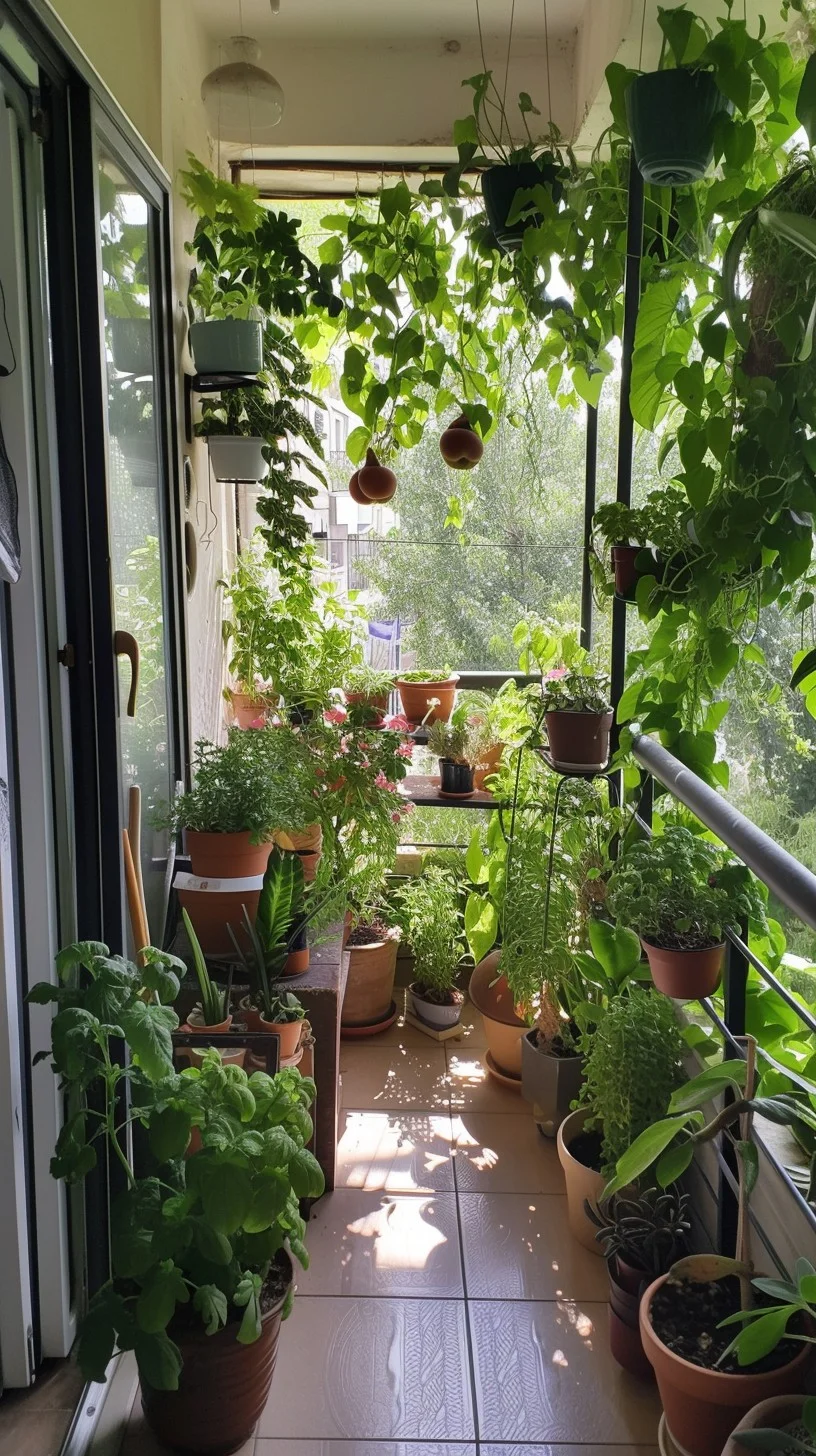Table of Contents
Balcony Garden Ideas

Creating a balcony garden can transform your outdoor space into a lush, vibrant retreat. Here are some creative and practical ideas Balcony Garden Ideas to help you design the perfect balcony.
1. Vertical gardens
Wall mounters:
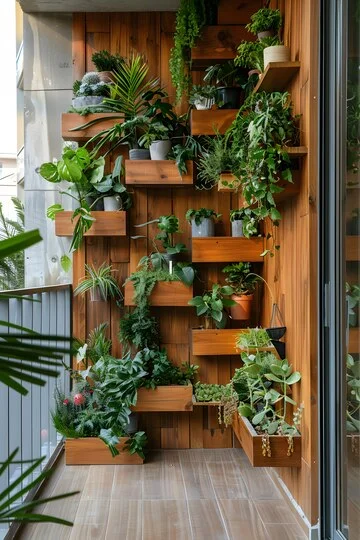
- Description: Wall planters are mounted directly on walls or fences making efficient use of vertical space. They come in different forms such as pocket, shelf, and modular systems.
- Installation: Attach to walls or railings using brackets or hooks. Make sure they are securely fastened to support the weight of the soil and plants.
- Advantages: Ideal for small balconies where floor space is limited. They also provide a lush, green backdrop and can be a focal point.
- Plant choices: Herbs like basil and mint, small flowering plants like petunias, or succulents.
Hanging Planter:

- Description: These are planters that hang from hooks or brackets on the ceiling or railing.
- Installation: Secure the hooks or brackets to the balcony ceiling or railing. Make sure the planters are rated to hold their weight.
- Benefits: Keeps floor space clean and adds visual interest at different heights.
- Plant choices: trailing plants such as ivy, pothos, and ferns, or flowering plants such as trailing geraniums.
Trellises:
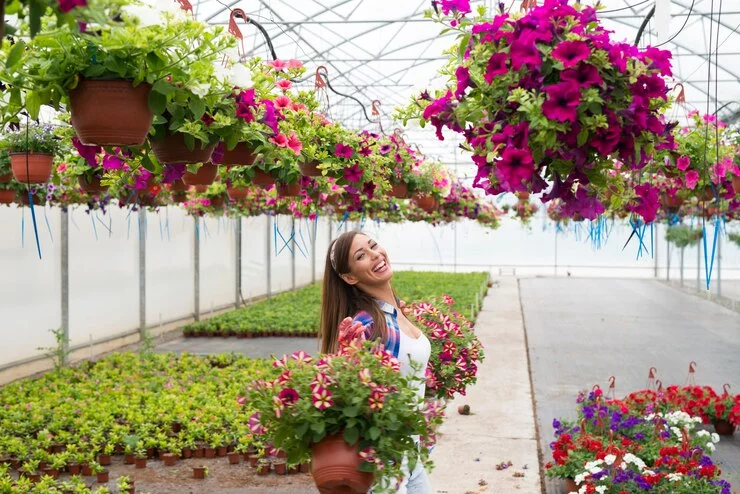
- Description: Trellis are structures that support climbing plants. They can be freestanding or attached to walls.
- Installation: Fix the trellises to the walls or use the freestanding version if wall space is not available.
- Benefits: Provides vertical interest and is great for growing plants that need support.
- Plant choices: beans, peas, cucumbers, or flowering vines such as morning glories and clematis.
2. Container garden
Potted Plants:

- Description: Growing plants in individual pots or containers.
- Types: Pots come in a variety of materials such as ceramic, plastic, and metal, and sizes range from small to large.
- Advantages: Flexible and portable. It’s easy to rearrange and replace plants as the seasons change.
- Plant choices: flowers like marigolds and petunias, herbs like rosemary and thyme, and vegetables like cherry tomatoes.
Stackable Planter:

- Description: Planters that can be placed vertically to maximize space.
- Installation: Place planters on top of each other, ensuring stability. Some models come with a built-in irrigation system.
- Advantages: Efficient use of space, and often include integrated watering systems.
- Plant choices: Herbs, compact vegetables like lettuce, or ornamental plants.
Raised bed:
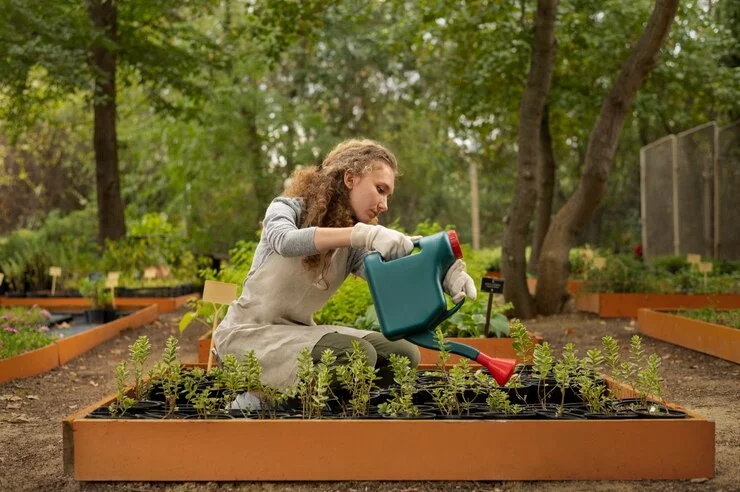
- Description: Raised gardens that provide deep soil and better drainage.
- Installation: Can be purchased or made from wood, metal or other materials. Place them on the balcony floor or use a raised platform.
- Advantages: Ideal for growing larger plants or vegetables and can improve accessibility.
- Plant choices: vegetables like carrots and beets, or large flowers like sunflowers.
3. Edible gardens
Herb Garden:
- Description: A collection of herbs grown in pots or containers.
- Setup: Use small pots or a large container with multiple herbs. Ensure proper drainage.
- Benefits: Provides fresh herbs for cooking and can be grown year-round.
- Herbs: Basil, mint, parsley, thyme and cayenne pepper.
Vegetable Garden:
- Description: Growing vegetables in containers or raised beds.
- Setup: Use large containers or raised beds for vegetables. Make sure they get adequate sunlight and water.
- Benefits: Fresh, home-grown vegetables are easy and affordable.
- Vegetables: Cherry tomatoes, bell peppers, lettuce, spinach and radishes.
Fruiting plants:
- Description: Growing fruit plants in containers or dwarf trees.
- Setup: Use large pots or special containers for fruit trees. Make sure they have enough room for root growth.
- Benefits: Enjoy fresh fruits from your garden. Dwarf varieties are suitable for small spaces.
- Fruits: Strawberries, blueberries, dwarf citrus trees (such as lemons or limes), and grapes.
4. Decorative elements
Pre-Lights:
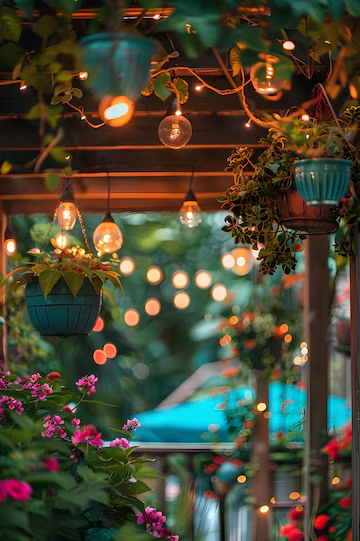
- Description: String lights that create ambiance in the balcony.
- Installation: Hang from railings, ceiling, or walls. Use battery-powered or solar-powered lights to avoid the need for electrical outlets.
- Benefits: Creates a comfortable and inviting atmosphere, especially in the evenings.
- Types: LED fairy lights, lantern-style lights, or string lights with decorative elements.
Outdoor carpets:
- Description: Weather resistant carpets designed for outdoor use.
- Installation: Place on the balcony floor to define the space and add comfort.
- Benefits: Adds color and texture to the balcony, making it feel like an outdoor room.
- Types: Made from materials like polypropylene, which is durable and easy to clean.
Garden furniture:
- Description: Furniture designed for outdoor use.
- Installation: Choose compact, foldable, or stackable furniture to maximize space.
- Pros: Provides seating and dining options, making the balcony more functional.
- Types: Bistro seats, folding chairs, compact benches and small tables.
5. Green screen
Privacy Screens:
- Description: Screens or panels used to create privacy and prevent unwanted views.
- Installation: Attach to railings, walls, or use freestanding screens.
- Benefits: Creates a secluded spot and can also serve as a backdrop for climbing plants.
- Types: Bamboo curtains, mesh panels, or fabric curtains.
Shade Solution:
- Description: Structures or materials used to provide shade.
- Installation: Use outdoor curtains, awnings, or shade sails.
- Benefits: Protects plants from strong sunlight and creates a comfortable place to rest.
- Types: Retractable awnings, outdoor curtains, or shade sails.
6. Seasonal and Thematic Balcony Garden Ideas
Weather display:
- Description: Change the plants according to the season to keep the garden fresh and interesting.
- Setup: Rotate plants and decorations based on the time of year.
- Benefits: Keeps the garden visually appealing throughout the year.
- Seasonal plants: Spring flowers such as tulips, summer greens, fall gourds, and winter evergreens.
Theme Parks:
- Description: Gardens designed around a specific theme or style.
- Setup: Choose plants, decorations, and layouts that match the theme.
- Benefits: Creates a unique and personal garden space.
- Themes: Mediterranean (with olive trees and lavender), tropical (with ferns and hibiscus), or Zen (with bonsai and minimalist designs).
7. Space saving solutions
Foldable Furniture:
- Description: Furniture that can be folded when not in use.
- Installation: Choose foldable options for easy storage.
- Advantages: Saves space and the balcony can be easily stowed away when not in use.
- Types: Folding tables, chairs or benches.
Multi-functional planter:
- Description: Planters that serve multiple purposes.
- Installation: Look for planters that double as seating or storage.
- Advantages: Maximizes functionality and space efficiency.
- Examples: Planter benches or tables with built-in planters.
Wall Mounted Shelf:
- Description: Balcony wall mounted shelf for extra planting space.
- Installation: Attach the shelves to the wall, making sure they can support the weight of the plants.
- Advantages: Provides additional space for smaller plants and can be a decorative feature.
- Types: Floating shelves, tiered shelving units, or modular systems.
8. DIY and Up cycled Projects
Up Cycle Containers:
- Description: Reuse old crates, cans, or wooden pallets as plant pots.
- Setup: Clean and prepare containers for planting.
- Advantages: Eco-friendly and cost-effective.
- Ideas: painted tin cans, wooden boxes, or old drawers.
DIY Planter:
- Description: Create custom planters from materials such as concrete, wood, or terracotta.
- Setup: Use templates or frame to create unique planters.
- Advantages: Allows for creativity and customization.
- Ideas: concrete blocks, painted terracotta pots, or wooden crates.
9. Climate and Sunlight Considerations
Sunlight:
- Description: Choosing plants based on the amount of sunlight your balcony receives.
- Setup: Arrange the plants according to their light needs.
- Benefits: Ensures plants thrive in their specific light conditions.
- Varieties: Shade tolerant plants for low light areas, sun loving plants for bright areas.
Climate:
- Description: Choosing plants that are suitable for your local climate.
- Setup: Choose plants based on temperature, humidity and weather conditions.
- Benefits: Ensures plant health and longevity.
- Types: Drought tolerant plants for dry climates, moisture loving plants for humid areas.
How to Create a Balcony Garden: A Step-by-Step Guide
Creating a balcony garden is an excellent way to bring a slice of nature into your home, especially if you live in an urban area. Not only does it beautify your space, but it also offers a peaceful retreat and the potential for growing your herbs, flowers, or even vegetables. This guide will take you through all the necessary steps to create a flourishing balcony garden that is easy to maintain and Google-friendly, focusing on SEO tips for increased visibility.
Step 1: Assess Your Balcony Conditions
Before diving into the world of balcony gardening, it’s crucial to understand your balcony’s specific conditions. This will ensure that your garden thrives in its environment.
Sunlight Exposure:
One of the most important factors is how much sunlight your balcony receives. South-facing balconies get full sun, while north-facing ones tend to be shadier. The type of sunlight will dictate which plants you should grow. For example:
- Full-sun plants: Tomatoes, peppers, succulents, and lavender.
- Shade-tolerant plants: Ferns, ivy, begonias, and hostas.
Wind Conditions:
Balconies, especially those on higher floors, can be quite windy. Opt for sturdy plants or provide windbreaks like lattices or bamboo screens.
Space Availability:
Evaluate how much space you have. You don’t need a large area; even a small balcony can host a beautiful garden with proper planning.
Step 2: Plan Your Balcony Garden Layout
Once you’ve understood your balcony’s conditions, the next step is to design the layout. Keep these factors in mind:
Vertical Gardening:
Maximize space by going vertical. Use hanging baskets, vertical planters, or shelves to grow plants upward, saving floor space for larger plants or seating areas.
Container Selection:
Containers are crucial for balcony gardens. Choose containers with proper drainage holes to avoid waterlogging. Terracotta, ceramic, or plastic pots work well, but consider the weight—especially if you’re working with limited structural support on a high-rise balcony.
Plant Grouping:
Group plants based on their sunlight, water, and care needs. For example, herbs like basil, oregano, and mint grow well together, while succulents and cacti need different care from leafy greens.
Step 3: Choose the Right Plants for Your Balcony Garden
Selecting the right plants is key to creating a successful balcony garden. Here are a few popular options:
Herbs:
Herbs are easy to grow and thrive in small spaces. You can grow them in pots or hanging containers. Popular choices include:
- Basil
- Thyme
- Parsley
- Mint
- Rosemary
Flowers:
Flowers will add a splash of color to your garden. Opt for species that do well in containers, such as:
- Petunias
- Marigolds
- Geraniums
- Pansies
- Impatiens (for shaded areas)
Vegetables:
Yes, you can even grow vegetables on your balcony. Smaller varieties or dwarf versions work well. Consider these vegetables for your space:
- Cherry tomatoes
- Peppers
- Lettuce
- Spinach
- Radishes
Succulents and Cacti:
For low-maintenance greenery, succulents and cacti are great options. They are drought-tolerant and can survive in various lighting conditions, especially in sunnier areas.
Step 4: Soil and Watering Needs
Balcony gardens generally require well-draining soil, especially since containers can retain excess moisture, which can lead to root rot. Use high-quality potting soil with organic compost to give plants the nutrients they need. Avoid using garden soil, as it’s too dense for container gardening.
Watering:
Each plant has different watering needs. Some, like succulents, thrive on little water, while others, like herbs, need more regular watering. Consider self-watering pots or create a schedule to avoid under or over-watering.
To prevent water spillage on your balcony (or your neighbor’s below), use saucers under your pots to catch excess water. Alternatively, line your balcony with waterproof material to keep it protected.
Step 5: Add Functional and Aesthetic Elements
Creating a balcony garden isn’t just about the plants. The overall design will enhance your outdoor space, making it a place you’ll want to spend more time in.
Furniture:
Invest in space-saving furniture, like foldable chairs or a small bistro table. This allows you to enjoy your garden while reading, sipping tea, or just relaxing.
Lighting:
String lights, lanterns, or solar-powered lights can create a cozy atmosphere during the evening. Additionally, they don’t take up much space but make the garden more inviting.
Decor:
Add personal touches with garden décor such as statues, bird feeders, or wind chimes. Don’t go overboard, as too many elements can clutter your space, making it look smaller.
Step 6: Regular Maintenance of Your Balcony Garden
Maintaining your balcony garden is essential to keep it flourishing. Regular tasks include:
Watering and Fertilizing:
Keep a close eye on your plants’ water needs, especially during hot summer months. Fertilize your plants monthly using a balanced, organic fertilizer.
Pruning and Deadheading:
Remove dead flowers and trim overgrown plants to keep them healthy and encourage new growth.
Pest Control:
Keep pests like aphids and spider mites at bay by regularly inspecting your plants. Use natural remedies like neem oil or introduce beneficial insects like ladybugs to your garden.
Step 7: Sustainability Tips for Your Balcony Garden
- Composting: Create a small compost bin or use a worm composter to recycle kitchen scraps into nutrient-rich soil for your plants.
- Water Conservation: Collect rainwater in a small barrel or use greywater from your kitchen (without chemicals) to water your plants.
- Reuse Containers: Upcycle containers like tin cans, wooden crates, or old ceramic pots to grow your plants sustainably.
Best Plants for Balcony Decoration
Decorating your balcony with plants can transform it into a beautiful, serene space, whether you’re looking for lush greenery, colorful flowers, or low-maintenance options. The best plants for balcony decoration will depend on the amount of sunlight, space, and the aesthetic you want to achieve. Here’s a list of top plants that work great in balconies, categorized by their decorative appeal and ease of care.
1. Flowering Plants
Flowers are perfect for adding vibrant color to your balcony and creating a lively atmosphere. Here are some of the best flowering plants for balcony decoration:
- Geraniums:
Known for their bright blooms, geraniums are low-maintenance and thrive in sunny conditions. They come in a variety of colors like red, pink, white, and purple, making them perfect for adding color to your balcony.
- Petunias:
Petunias offer a cascade of colorful flowers that look great in hanging baskets or pots. They thrive in full sun and are perfect for adding a bright, cheerful look.
- Begonias:
Ideal for shaded balconies, begonias come in a range of colors from red to white. Their waxy leaves and lush flowers make them a stunning addition to any balcony garden.
- Marigolds:
Marigolds are hardy, sun-loving plants with bright yellow, orange, and red blooms. They are perfect for adding a splash of color and are easy to care for, making them great for beginner gardeners.
2. Climbing Plants
If you have limited space but want to create a lush, green environment, climbing plants are a great choice. They can grow vertically on trellises or walls, adding height and dimension to your balcony.
- Ivy (Hedera helix):
Ivy is a classic climbing plant that adds a green, romantic touch to any space. It grows well in shady areas and is ideal for covering walls or creating a green privacy screen.
- Jasmine (Jasminum):
Jasmine not only provides a beautiful display of white, fragrant flowers, but it also thrives in sunny conditions. It’s perfect for balconies with trellises or railing to allow it to climb.
- Bougainvillea:
Bougainvillea is a stunning climber that produces bright, vibrant flowers in pink, purple, red, or white. This plant thrives in full sun and is drought-tolerant, making it ideal for balconies in hot climates.
3. Herbs for Balcony Gardens
Herbs can be decorative and useful at the same time, adding beauty and function to your balcony. They’re great for small spaces and can be grown in containers or hanging baskets.
- Basil:
Basil’s bright green leaves add fresh color to your balcony while being perfect for your kitchen. It thrives in warm, sunny conditions and is relatively easy to maintain.
- Mint:
Mint is a fast-growing herb with a pleasant aroma and bright green foliage. It can be grown in pots to control its spread, and it adds a fresh vibe to any balcony garden.
- Lavender:
Lavender is perfect for sunny balconies, offering a beautiful blend of fragrance and purple blooms. Its silvery-green leaves add a calming, Mediterranean feel to any outdoor space.
- Rosemary:
Rosemary’s needle-like leaves and upright growth make it a decorative and aromatic herb. It prefers full sun and well-draining soil, making it a great choice for balconies with good light exposure.
4. Succulents and Cacti
If you’re looking for low-maintenance plants for balcony decoration, succulents and cacti are excellent choices. They’re hardy, require little water, and come in a variety of shapes and colors.
- Aloe Vera:
Aloe Vera’s thick, spiky leaves give it a modern and minimalistic appearance. It thrives in bright sunlight and requires very little water, making it perfect for sunny balconies.
- Echeveria:
This rosette-shaped succulent comes in shades of green, blue, and even purple. It’s great for small spaces as it can be planted in pots or window boxes and requires minimal care.
- Cactus (Various Species):
Cacti are some of the easiest plants to care for, needing little water and thriving in sunlight. They come in all shapes and sizes, from small potted varieties to taller types that can stand alone as decorative focal points.
5. Foliage Plants
For a rich, green environment, foliage plants add depth and texture to your balcony without the need for flowers. Their lush leaves are often the highlight, making them ideal for a calming, tropical atmosphere.
- Ferns (Boston Fern, Asparagus Fern):
Ferns are great for shaded balconies and add a lush, tropical feel to your space. Boston ferns are particularly popular due to their full, cascading leaves.
- Spider Plant (Chlorophytum comosum):
The spider plant is an excellent choice for hanging baskets or pots. Its long, striped leaves create a striking visual effect, and it’s very easy to care for, thriving in indirect light.
- Snake Plant (Sansevieria):
Also known as Mother-in-Law’s Tongue, the snake plant has tall, upright leaves that create a bold look. It’s highly resilient and thrives in low light, making it ideal for any balcony condition.
- Philodendron:
This popular houseplant also works great in outdoor settings, especially on shaded balconies. Its heart-shaped leaves create a lush, tropical vibe, and it can either trail from pots or climb structures.
6. Ornamental Grasses
Ornamental grasses are a unique way to add texture and movement to your balcony. They sway gently in the wind, creating a dynamic, natural aesthetic.
- Fountain Grass (Pennisetum setaceum):
This elegant grass forms soft, feathery plumes that move gracefully in the wind. It adds height and visual interest to your balcony, especially when placed in taller containers.
- Blue Fescue (Festuca glauca):
Blue Fescue is a compact ornamental grass with striking blue-gray foliage. It adds a modern and sophisticated touch to any balcony and does well in full sun.
7. Hanging Plants
Hanging plants are perfect for small balconies, as they allow you to add greenery without taking up valuable floor space.
- String of Pearls (Senecio rowleyanus):
This succulent looks stunning when trailing from hanging pots, with its unique bead-like leaves cascading over the edge.
- Fuchsia:
Fuchsia’s pendulous flowers make it a favorite for hanging baskets. It thrives in partial shade and adds a touch of elegance to your balcony with its delicate, bell-shaped flowers.
- Trailing Lobelia:
Lobelia is an excellent hanging plant for balconies, producing cascades of tiny, vibrant blue, purple, or white flowers. It’s perfect for adding a soft, colorful look to your space.
Balcony Garden FAQ (Frequently Asked Questions)
1. What are the best plants for a sunny balcony?
Plants that thrive in full sunlight are ideal for sunny balconies. Popular options include succulents, lavender, geraniums, petunias, and rosemary. These plants require plenty of sunlight to grow and can handle direct exposure to the sun.
2. What are the best plants for a shady balcony?
If your balcony is more shaded, opt for plants that tolerate low light. Some excellent options include ferns, ivy, begonias, hostas, and spider plants. These plants thrive in indirect light and shaded conditions.
3. How can I maximize space on a small balcony?
For small balconies, maximize vertical space by using hanging baskets, wall-mounted planters, and vertical gardening racks. You can also use multi-tiered plant stands or stack pots to make the most of limited floor space.
4. Do I need special soil for balcony plants?
Yes, it’s recommended to use well-draining potting soil for container gardening. Regular garden soil can become too compact in pots, leading to poor drainage. You can mix organic compost into your potting soil to improve nutrient levels.
5. How often should I water my balcony plants?
Watering frequency depends on the plant type, climate, and pot size. In general:
- Succulents and cacti need watering once every 1–2 weeks.
- Flowering plants may need watering 2–3 times a week.
- Herbs and vegetables need consistent moisture, usually 3–4 times a week.
Ensure that your containers have proper drainage to avoid waterlogged roots.
6. Can I grow vegetables on my balcony?
Yes, many vegetables can be grown on a balcony, even in small spaces. Cherry tomatoes, peppers, lettuce, spinach, radishes, and herbs like basil and mint grow well in containers. Make sure your plants receive enough sunlight and water regularly.
7. What type of containers should I use for balcony gardening?
Use containers with drainage holes to prevent waterlogging. You can choose terracotta, ceramic, or plastic pots, as well as hanging baskets or vertical planters. Make sure the size of the container is appropriate for the plant’s root system.
8. How can I protect my balcony plants from wind?
To shield plants from strong winds, you can:
- Use windbreaks like lattice screens or bamboo partitions.
- Group plants together to create a barrier.
- Choose sturdy plants or secure tall plants to stable supports.
9. How do I prevent pests in my balcony garden?
To keep pests away:
- Regularly inspect your plants for any signs of pests like aphids or spider mites.
- Use natural pest control methods such as neem oil or insecticidal soap.
- Introduce beneficial insects like ladybugs to keep pest populations in check.
10. How can I create a low-maintenance balcony garden?
For a low-maintenance garden, choose plants that require minimal care, like succulents, cacti, or ornamental grasses. Set up a self-watering system or use self-watering pots. Also, opt for plants that don’t need frequent pruning or fertilizing.
11. Can I grow a balcony garden in a cold climate?
Yes, you can still have a balcony garden in colder climates. Opt for cold-hardy plants like pansies, violas, or heucheras. Use insulated pots or move delicate plants indoors during the winter months. Additionally, you can use frost covers or small portable greenhouses for protection.
12. How can I make my balcony garden eco-friendly?
To make your garden more sustainable, you can:
- Compost your kitchen scraps to create natural fertilizer.
- Use rainwater or greywater for watering plants.
- Upcycle containers or old items as plant pots.
- Choose organic soil and fertilizers.
13. Can I have a balcony garden in an apartment?
Absolutely! Even small balconies in apartments can host a beautiful garden. You can grow herbs, flowers, succulents, or even vegetables in containers. Use space-saving techniques like hanging baskets, railing planters, or vertical gardens to optimize space.
14. What are the best fragrant plants for a balcony?
If you want your balcony garden to smell amazing, opt for fragrant plants such as jasmine, lavender, gardenias, roses, and thyme. These plants will add a beautiful fragrance to your outdoor space.
15. How can I maintain privacy with balcony plants?
Use tall plants or climbing plants like bamboo, ivy, or morning glories on a trellis to create natural privacy screens. You can also group plants in dense arrangements to create a green wall that offers seclusion while still beautifying your space.
Conclusion
Creating a balcony garden involves combining aesthetics, functionality and practicality to suit your space and lifestyle. By using vertical gardens, container gardens and decorative elements, you can transform your balcony into a vibrant oasis. Consider seasonal and themed designs, space-saving solutions, and DIY projects to personalize your garden. Pay attention to climate and sunlight requirements to ensure your plants thrive, and consult local gardening resources when needed. With thoughtful planning and creativity, your balcony can become a beautiful and functional outdoor retreat.
Choosing the right plants for your balcony decoration depends on your space’s sunlight, climate, and overall design aesthetic. Whether you’re going for a vibrant, colorful garden or a minimalist, green space, this selection of plants offers something for every type of balcony. By combining flowering plants, herbs, succulents, and hanging plants, you can create a beautiful and functional garden that enhances your outdoor living space. Read More

